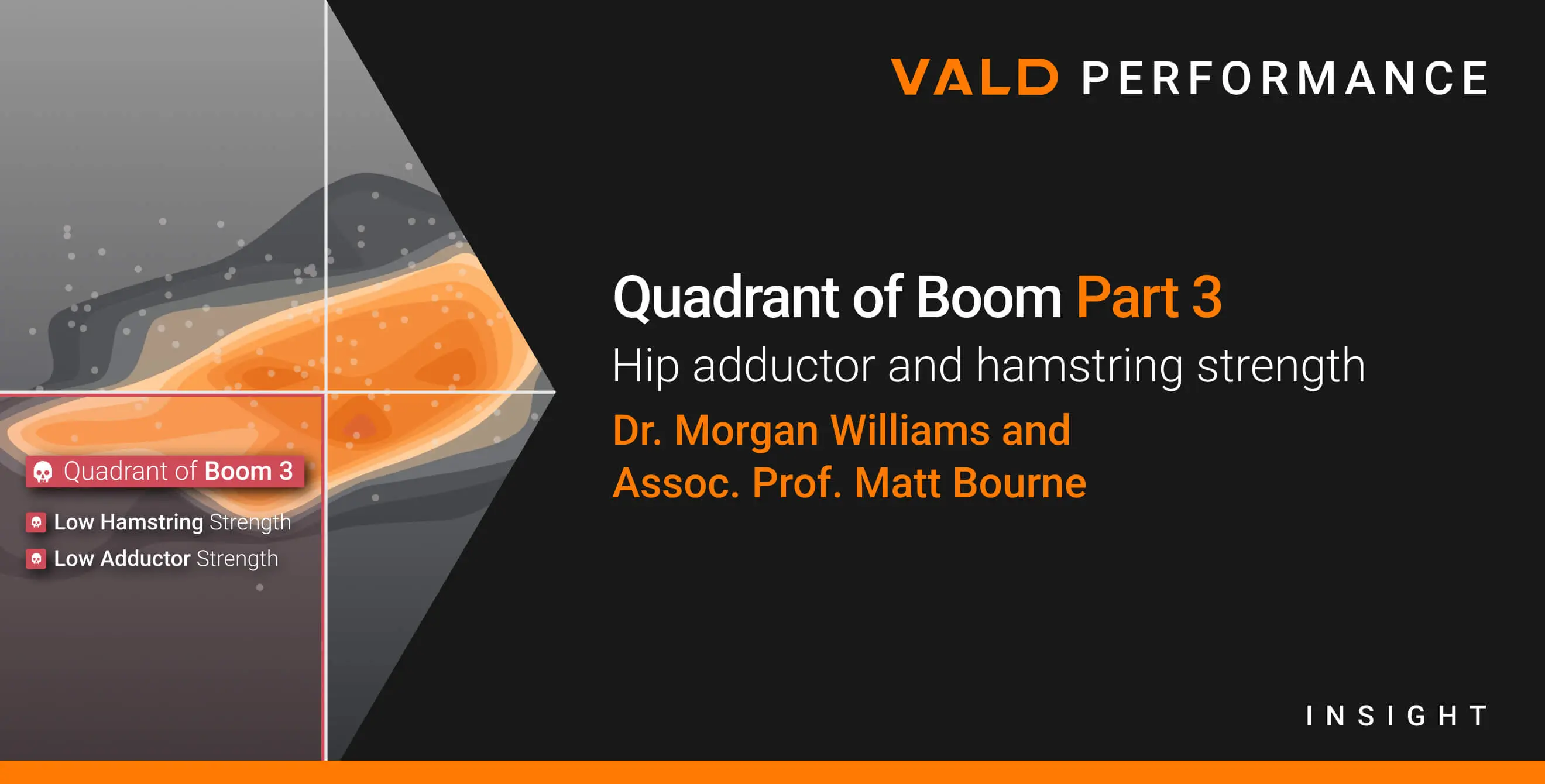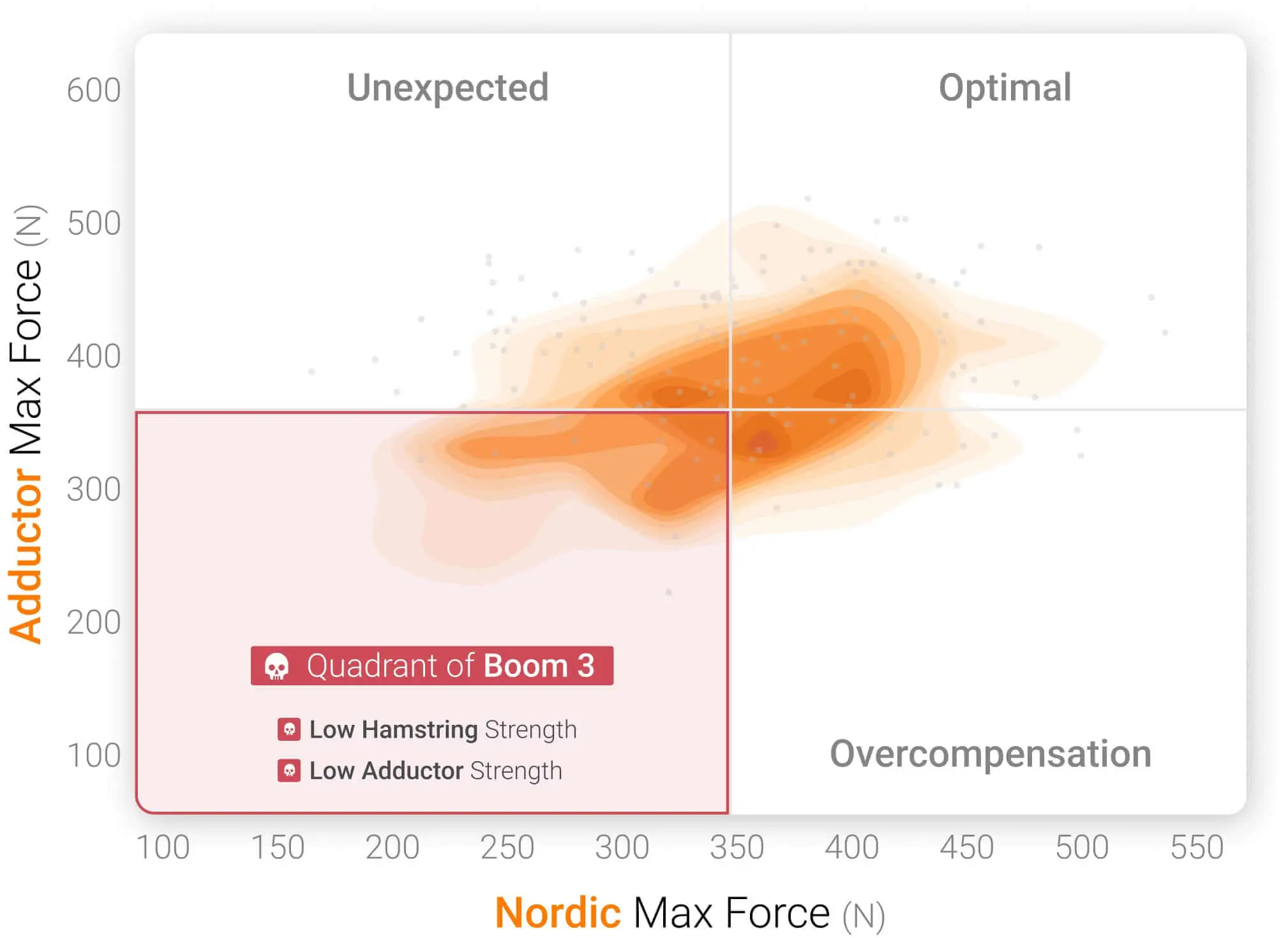Quadrant of Boom Part 3: Hip adductor and hamstring strength
Available in:
EN
About the Authors
Dr. Morgan Williams is a Data Scientist at VALD, an Adjunct Associate Professor at Griffith University’s School of Allied Health, Sport and Social Work and an external affiliate member of the Australian Centre for Precision Health and Technology (PRECISE). As part of the VALD Data Science Team, he uncovers new insights into VALD data and how it can be used to enhance practice.
Associate Professor Matt Bourne is a Principal Research Fellow at Griffith University and spearheads the Precision Athlete research program at the PRECISE. He leads a multidisciplinary research team focused on developing and applying innovative technologies to optimize performance and predict, prevent and recover from sports injuries.
Eccentric hamstring strength is a critical quality for reducing injury risk and enhancing high-speed running performance. Its importance is well established in the literature and regularly emphasized in clinical and sporting environments.
The first two articles in the Quadrant of Boom series explored how eccentric hamstring strength relates to key performance indicators – first, peak sprint velocity and then momentum. Each comparison provided a visual framework to guide decision-making by combining commonly assessed variables in a single view.

In this final article, we examine the relationship between eccentric hamstring strength and isometric hip adductor strength – another key capacity linked to groin health, injury risk and movement control. Pairing measurement technologies such as ForceFrame and NordBord brings added context to athlete profiling, helping practitioners better interpret strength qualities across body regions and design more targeted training programs.
Inspired by field observations, analyzing eccentric hamstring strength alongside isometric adductor strength has provided valuable insights into sprint performance, as well as injury and re-injury risk.
…analyzing eccentric hamstring strength alongside isometric adductor strength has provided valuable insights into sprint performance, injury and re-injury risk.
Retrospective analysis of professional rugby athletes showed that those with recurrent hamstring strains had lower adductor strength relative to hamstring strength. Conversely, athletes who avoided re-injury either maintained high adductor strength or improved it during rehabilitation, highlighting the adductor’s role in hamstring injury risk profiling (Williams et al., 2025).
The relationship between the hamstring and hip adductor muscle groups makes intuitive sense, yet it appears to be underrepresented in the sports performance and injury literature. Notably, the adductor magnus is often referred to as the “fourth hamstring” due to its primary role as a hip extensor, particularly when the hip is flexed. Recent data revealed that the torque-generating capacity of the adductor magnus was 2x greater for hip extension than adduction (Takahashi et al., 2025).

The adductor magnus is designed to act primarily for hip extension rather than adduction.
Drawing on rugby union datasets (Ashcroft et al., In Press), which informed the Quadrant of Boom 3 visualization, isometric adductor and eccentric hamstring strength – when normalized to body mass – explained 42% of the variance in peak sprint velocity during 40m sprints. This demonstrates the combined role of these muscle groups in maximal sprinting performance.
Nearly 20 years ago, Chumanov et al. (2007) identified the adductor magnus as a key contributor to hip extension during the terminal swing phase of sprinting.
Nearly 20 years ago, Chumanov et al. (2007) identified the adductor magnus as a key contributor to hip extension during the terminal swing phase of sprinting. In addition, the authors proposed that the adductor magnus had the greatest potential of all lumbopelvic muscles (including the other hamstrings) to reduce biceps femoris stretch.

This reduction in biceps femoris stretch is important, as acute hamstring strains are thought to result from excessive negative musculotendon work over repeated strides (Chumanov et al., 2007).
…acute hamstring strain injuries are thought to result from excessive negative musculotendon work over repeated strides.
Interestingly, little research has examined the relationship between hamstring strength, hip adductor strength and subsequent hamstring strain injury. Historically, limited access to equipment capable of accurately and reliably measuring hip adductor strength may have been a barrier.
Now, thousands of organizations worldwide have access to fixed-frame dynamometers like ForceFrame and NordBord, and therefore have the capacity to explore these relationships.
Building the Quadrant of Boom 3
Using the same dataset (Ashcroft et al., In Press) as Part 1 and Part 2, this example plots Nordic maximum force against maximum force obtained from the isometric hip adductor assessment with the knees and hips at 90° of flexion, creating a new quadrant:
- Nordic force output can be placed on the x-axis.
- Isometric hip adductor force output can be placed on the y-axis.

Two assessments shown in the Quadrant of Boom 3 plot: Nordic hamstring curl and hip adduction at 90°.
The quadrant lines can be determined using the population median for each test. Alternatively, specific injury risk thresholds can be used. These thresholds can be found in the literature or from your own data. For example, in Major League Baseball, athletes with a preseason Nordic maximum force below 377N had a 2.5x higher risk of sustaining a hamstring strain injury (Driggers et al., 2025).
This configuration allows for visual profiling of eccentric hamstring muscle strength relative to isometric hip adductor strength, providing a practical framework for identifying strength characteristics relevant to sprint performance and injury risk.
This configuration [offers]…a practical framework for identifying strength characteristics relevant to sprint performance and injury risk.

Quadrant of Boom 3: Nordic max force and hip adductor force at 90°.
Quadrant Interpretation
This visualization reflects an expected balance between the two strength measures, ideally forming a diagonal trend from bottom left to top right of the quadrant. Athletes positioned along this spectrum are considered within normal variation.
However, those who deviate from this pattern may warrant further investigation. An athlete’s position within the Quadrant of Boom 3 helps guide targeted assessments, revealing patterns that might otherwise be overlooked. These may include compensatory strategies, asymmetric recovery or training biases – such as focusing on hamstring training during rehabilitation while neglecting the adductors.
Interpretation by Quadrant
| Quadrant | Population | Key Risk | Priority |
| Bottom Left (Low, Low) | Deconditioned, younger or injured athletes | Highest injury risk due to low capacity in both muscle groups | Implement general load progression for eccentric hamstring strength and progressive adductor loading |
| Top Left (Low, High) | Athletes with prior hamstring injury, or highly specialized athletes (e.g., high frontal plane demands) | High risk for future hamstring injury | Evaluate injury history, ensure eccentric hamstring strength is prioritized |
| Bottom Right (High, Low) | Athletes following successful hamstring injury rehabilitation, where the focus has been on rehabilitating the site of injury | Risk of altered swing mechanics and subsequent injury due to imbalance and overreliance on the hamstrings | Increase adductor strengthening, evaluate pelvic control in sprinting |
| Top Right (High, High) | Trained, healthy, high-performing athletes | Risk of strength loss over time due to insufficient training stimulus | Maintain intensity and volume to prevent detraining |
Generating a Quadrant of Boom
For practitioners with small or insufficient datasets, VALD publishes normative data reports that practitioners can use as a starting point to build a Quadrant of Boom 3. Nordic and hip adductor strength data for male and female soccer players from published reports are presented in the table below.
Male Soccer Players
| Percentile | Nordic Max Force (N) | Adductor Max Force (N) |
| 1st | 228 | 204 |
| 25th | 362 | 354 |
| 50th | 415 | 423 |
| 75th | 462 | 488 |
| 99th | 589 | 636 |
Female Soccer Players
| Percentile | Nordic Max Force (N) | Adductors Max Force (N) |
| 1st | 163 | 240 |
| 25th | 256 | 299 |
| 50th | 294 | 322 |
| 75th | 332 | 350 |
| 99th | 416 | 422 |
Additional datasets, such as the 2024/25 Premier League data report and the 2024/25 VALD Basketball report, can be accessed in VALD Hub.

To construct the quadrant, use the 50th percentile (median) values for the Nordic and adductor strength tests for the dividing lines. Alternatively, sport- or context-specific thresholds can be applied, such as the Major League Baseball Nordic strength benchmarks mentioned above.
Summary
This blog presents a practical framework for visualizing eccentric hamstring strength and isometric adductor strength, offering clearer insight into athlete risk profiles and performance capacity.
Grounded in field observations and supported by emerging literature, this approach can be easily applied in practice using NordBord and ForceFrame. Together, these systems provide fast, reliable strength data to inform programming, monitor progress and guide return-to-play decisions.
Practitioners are encouraged to explore these relationships using available tools and benchmarks to drive more individualized, objective athlete management.
If you would like to learn more about how you can leverage NordBord and ForceFrame testing to strengthen your profiling, programming and return-to-play decisions, get in touch with our team.
References
- Williams, K., van Dyk, N., Opar, D., Winkelman, N., & Williams, M. (2025). Lower limb muscle strength profiles and injury associations: A two-season prospective cohort study in men’s professional rugby union. Journal of Science and Medicine in Sport. https://doi.org/10.1016/j.jsams.2025.10.012
- Takahashi, K., Tozawa, H., Kawama, R., & Wakahara, T. (2025). Redefining muscular action: human “adductor” magnus is designed to act primarily for hip “extension” rather than adduction in living young individuals. Journal of Applied Physiology, 138(4), 1088–1099. https://doi.org/10.1152/japplphysiol.00600.2024
- Ashcroft, P., Williams, K., Raymond, W., Evans, N., Williams, R., Partridge, N., Williams, M. (In Press). Fitness characteristics of the Welsh Rugby Union's schools and colleges league players. International Journal of Strength and Conditioning.
- Chumanov, E. S., Heiderscheit, B. C., & Thelen, D. G. (2007). The effect of speed and influence of individual muscles on hamstring mechanics during the swing phase of sprinting. Journal of Biomechanics, 40(16), 3555–3562. https://doi.org/10.1016/j.jbiomech.2007.05.026
- Driggers, A. R., Fry, A. C., Chochrane-Snyman, K. C., Wagle, J. P., & McBride, J. M. (2025). Effectiveness of single leg isometric bridge and Nordic hamstring exercise testing for prediction of hamstring injury risk in professional baseball players. The American Journal of Sports Medicine, 53(12), 2924–2932. https://dx.doi.org/10.1177/03635465251371789
